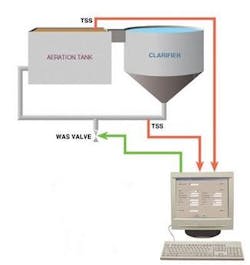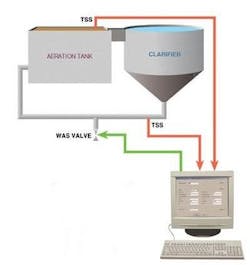Sludge Retention Time Control System Aids Wastewater Treatment
By Alex Ekster
Proper food-to-microorganism (F/M) population ratio is the single most important parameter affecting efficiency of an activated sludge system and the health of its biomass. Sludge wasting using solids retention time (SRT) criterion is based on the fact that constant SRT leads to constant F/M.
The waste flow is usually a small fraction of the influent flow; however, minimal variations of waste flow over time may have a profound effect on the performance of an activated sludge system. Inadequate wasting may cause clarifier overloading, low F/M bulking and foaming, and increased air demand for biomass endogenous respiration. Excessive wasting may cause poor removal of soluble pollutants, low dissolved oxygen (DO) bulking, and in the case of nitrification - excessive chlorine demand due to inadequate nitrite removal.
Wasting also affects sludge thickening processes not only because excessive wasting increases loads on the thickening facility, but, more importantly, because an increased daily variation in wasting biomass increases polymer consumption and reduces efficiency of all types of thickeners.
An automatic waste control system can provide constant accurate control over solids inventory, reduce the time required for sampling and sample processing, and eliminate human errors associated with wastage calculations and lag time. In addition, automatic waste control can stabilize sludge load to the sludge processing facilities.
A typical system consists of two suspended solids meters, a controller (computer), and a waste flowmeter with a valve for adjustment. Information from the suspended solid meters is sent to the controller, the controller compares the operational criteria such as mixed liquor TSS or solids retention time with the target value, calculates the necessary adjustment of the waste flow, and sends a signal to the control valve on the waste activated sludge (WAS) line.
Occasional problems with the suspended solids meters may have devastating results if they are not detected automatically. The SRTmaster control system supplied by Ekster and Associates addresses this challenge by using a system that not only detects meter malfunctions and switches the control algorithm to a safe mode but also detects process related problems and offers solutions to an operator. The algorithm also switches to an alternative control mode if any secondary process parameters such as mixed liquor suspended solids concentration, waste flow, wasted mass, etc., are exceeding limits.
Another challenge of SRT control is the fact that true mean cell residence time is not equal to instantaneous SRT. Ekster and Associates addresses this concern by tuning the SRT controller prior to delivery to a customer using a computerized model of the customer's activated sludge system.
The time over which SRT numbers should be averaged to reflect true mean cell residence time is found during the tuning. This time depends on the customer's SRT set point, wastewater characteristics, design and operational features of the customer's activated sludge system and can only be found using a computerized activated sludge model calibrated for the customer's conditions.
The customized SRT control algorithm helps maintain true biological activated sludge age. Of course, the peak performance of an activated sludge process can only be achieved if the SRT set point is optimized. Ekster and Associates have developed a methodology of selecting the optimum SRT set points as well as selecting limits for the secondary process parameters.
Case Studies
After installation of an SRT control system using the SRTmaster control algorithm, a significant reduction of TSS and waste mass variations were observed at a 667,000 m3/day conventional activated sludge system located at the main treatment plant for the City of Toronto, Canada.
Variation of waste (RASSS) and MLSS concentrations were reduced by almost a factor of three, while the variation of mass waste stream was reduced by a factor of seven.
A significant reduction of variations in the waste stream mass improved the operation of the thickening facility and the earlier practice of bypassing caused by thickening facility overload became unnecessary. Significant (up to 50%) reduction of polymer usage was also observed.
Several times the robustness of the control system was challenged when RAS flow to the sampling sink was interrupted, and as a result, the RASSS meters produced invalid readings. The control system automatically detected problems with RASSS readings and not only initiated alarms but also changed the control algorithm to disregard the faulty readings. Once conditions returned to normal, the controller automatically changed the control algorithm back to the one used prior to the encountered problems.
The system was also used at a 600,000 m3/day Biological Nutrient Removal System located at the San Jose/Santa Clara Water Pollution Control Plant in California.
Prior to implementation of the automatic SRT control, the facility had experienced significant foaming problems. Since installation was completed, no incidents of nocardioform foaming have occurred.
It is suggested that the reason for the absence of nocardioform foaming is that SRT control with automatic sludge wasting allows much less variation in SRT values than manually controlled wasting based on laboratory TSS analyses.
Long sludge retention times and a drastic reduction in waste flow increases nocardioform populations in aeration tanks. These organisms concentrate in the foam layer and are retained in the activated sludge system by the surface-foam-trapping features of the aeration basin even when the SRT is lowered.
With continuous TSS measurements and automatic sludge wasting control, there were no incidents of a drastic decrease in waste flow and no nocardioform growth. It is interesting to note that with automatic SRT control it was possible to operate in a nocardioform foam-free condition with a longer average SRT (6.3 days) than with manual activated sludge wasting based on daily laboratory TSS analyses (5.1 days).


